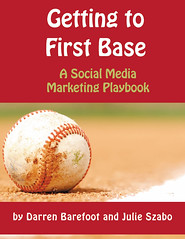
This book was an easy, fun, read, and seemed especially pertinent after all the immersion into social networking I’ve been doing with SXSW Interactive. The 100-page book, Getting to First Base: A Social Media Marketing Playbook, is aimed at your company’s marketing department for them to read before deep-diving into the social media landscape. Julie Szabo and Darren Barefoot share their stories and even their somewhat embarrassing lessons learned, sparing you from the same fate while also encouraging you to start the conversation.
At talk.bmc our entire intent was to start the conversation. So I know how daunting and intimidating it can be, yet you also have to dive in and sit back and listen. It’s not an easy road to walk. But sometimes ROI stands for Risk of Inaction, so eventually you should learn your way around the tools of the trade. I still like Reach Or Influence for the ROI acronym when applied to blogging. 🙂
This book gives you specific examples of tools and technology you can use to start the conversation, and also has the proper amount of caution about being genuine and having good intentions. One of my favorite quotes:
The vast majority of products are
ordinary. Worse, most customers
have made their buying decisions
about staple purchases years ago,
and it’s difficult to change their
minds.
So, what to do? Pull off the “online equivalent of a publicity stunt,” create a meme. To me, this is such a daunting task I can’t imagine writing a book about how to do it. But sure enough, these two have the experience and case studies to show for it.
I also liked the “influencer” chapter, describing the rules for interaction with bloggers. Looking at it as a blogger rather than a marketer, it’s good insider information to have. For example, check out this trick! Let’s say someone has a feedburner feed, but they haven’t published that little graphic that shows how many subscribers they have. Just insert /~fc/ into their feedburner URL, and voila, you have the little graphic! Example: http://feeds.feedburner.com/~fc/JustWriteClick. Super secret way to check out your friend’s blogs and see if they have any subscribers to speak of.
Glory be, they like their technical writers as monitors!
Darren has a background as a technical writer, and when the book talks about who is a good candidate for the sometimes time-consuming task of monitoring the blogosphere, I’ll bet it’s Darren who’s giving the nod to the technical writer. My other favorite quote:
On the development side, technical support engineers
or technical writers are often a good choice. They’re good
communicators, tend to have a broad awareness of the
company’s products, and can even reply to basic
support-related posts.
I agree whole heartedly. I think the Agile technical writer that Sarah Maddox describes is precisely the right person to be identifying keywords, get RSS watch lists configured, and read, read, read, and respond when necessary or find someone in our company who can respond correctly.
Wikipedia doesn’t like marketers – tread carefully
And, my personal favorite topic, wikis, is addressed. The book has an excellent section about what to do and what not to do when it comes to the tricky waters of Wikipedia. To me, this section alone is worth the $29 for this book! Solid advice with the proper amount of respect for the community behind Wikipedia.
All in all, nicely done and a great read for marketers and bloggers alike.